Update Notice (13th October 2023) : New data of ‘InnerForce Layer ALC’ measured in 2018 has been added. ‘InnerForce Layer ALC’s measured in 2023 are thicker, heavier and more elastic than those measured in 2018. TTGearLab will deal with those two versions as different blades. Both of two versions are shown in this article.
1. Introduction
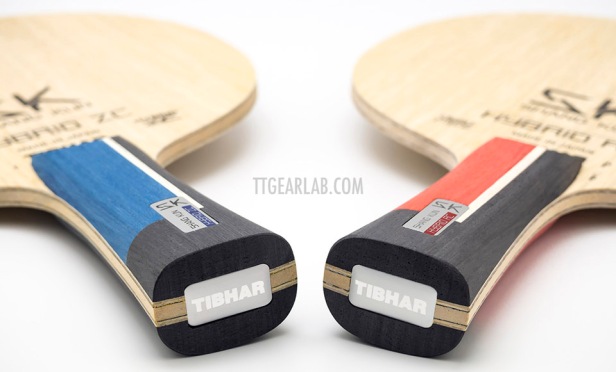
Fig.01 Tibhar ‘Shang Kun’ series
Tibhar ‘Shang Kun’ series is new top blade family from Tibhar in 2020 season. As its name expresses, ‘Shang Kun’ series is named after Chinese player – Shang Kun. Before ‘Shang Kun’ series, Tibhar had introduced two top blade families – ‘Fortino’ series introduced in 2019 and ‘Hybrid ZC’ series introduced in 2018. ‘Hybrid ZC’ series is composed of two outer-fiber models made in Japan. ‘Hybrid ZC’ means ZLC (= Zylon Carbon). ‘Fortino series’ is composed of three models – one outer-fiber model and two inner-fiber models – whose fiber is new Dyneema carbon. New ‘Shang Kun’ series can be considered as the successor of ‘Hybrid ZC’ series because it includes a model whose fiber is also ‘Hybrid ZC’. But, with Shang Kun series, Tibhar introduces a new fiber – Hybrid AC. As Hybrid ZC means ZLC (= PBO Carbon), Hybrid AC means ALC, i.e. Arylate Carbon.
In Japan, this series is called by different name – ‘Hybrid Inside’ series. Japanese name of ‘Shang Kun Hybrid ZC’ and ‘Shang Kun Hybrid AC’ are ‘Hybrid ZC Inside’ and ‘Hybrid AC Inside’ respectively. That is because ‘SK’ which is the abbreviation of Shang Kun can’t be used in Japan due to the existence of Butterfly ‘SK’ series.

Fig.02 Tibhar ‘Shang Kun’ series
‘Shang Kun’ series is composed of two models – ‘Shang Kun Hybrid ZC’ and ‘Shang Kun Hybrid AC’. You will be able to understand that those two are ‘Shang Kun ZLC’ and ‘Shang Kun ALC’. But, Tibhar doesn’t like to use the common words such as ‘ZLC’ and ‘ALC’. ‘Hybrid ZC (= ALC)’ seems to be the same material as the fiber for ‘Kinetic Speed’ and ‘Cedric Nuytinck’.
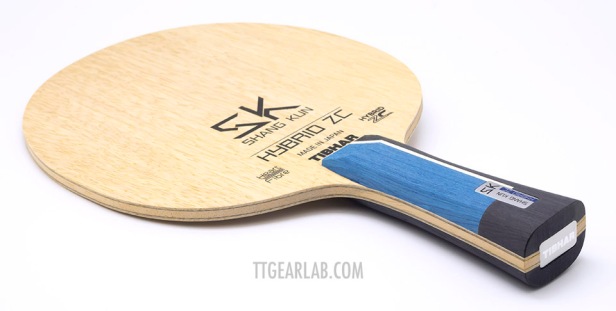
Fig.03 Tibhar ‘Shang Kun Hybrid ZC’
‘Shang Kun Hybrid ZC’ is the top model of new ‘Shang Kun’ series. And, it will be considered as the main model of ‘Shang Kun’ series because it is being use by Shang Kun. As its name expresses, its fiber is Hybrid ZC (= ZLC). The size of head is about 159.5 mm x 151mm. And, the length of handle is about 102mm. Average weight is about 91 gram. Nameplate on the forehand side of handle is made of Aluminum. At the end of handle there is the Aluminum plate with Tibhar logo.
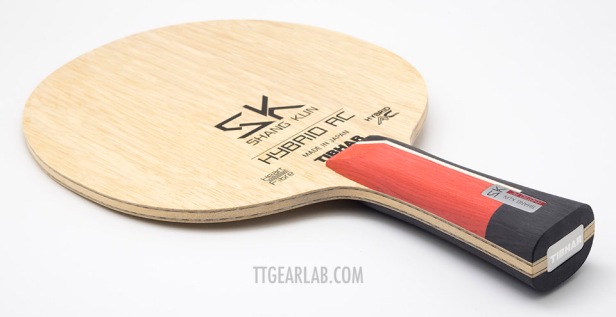
Fig.04 Tibhar ‘Shang Kun Hybrid AC’
‘Shang Kun Hybrid AC’ is another model of ‘Shang Kun’ series. And, it is the first Tibhar blade which is equipped with Hybrid AC (= ALC). Graphic design of ‘Shang Kun Hybrid AC’ is almost same as that of ‘Shang Kun Hybrid ZC’ except for color of handle block. Bright red is applied for the handle of ‘Shang Kun Hybrid AC’ while sky blue is applied for the handle of ‘Shang Kun Hybrid ZC’. The size of head is also about 159.5 mm x 151mm. And, the length of handle is about 102mm. Average weight is about 88 gram. Nameplate on the forehand side of handle is made of Aluminum. At the end of handle there is the Aluminum plate with Tibhar logo.
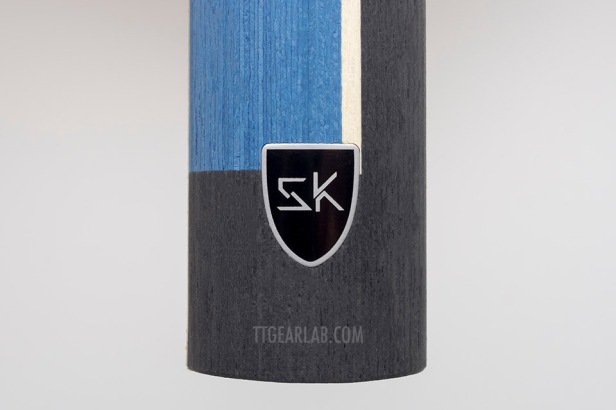
Fig.05 Backside Aluminum plate with the initial of Shang Kun
There is another small Aluminum plate on the backhand of handle. Backside Aluminum plate includes the logo of ‘Shang Kun’ series which expresses the initial of Shang Kun. It adds high quality look to ‘Shang Kun’ series whose overall quality is already excellent.
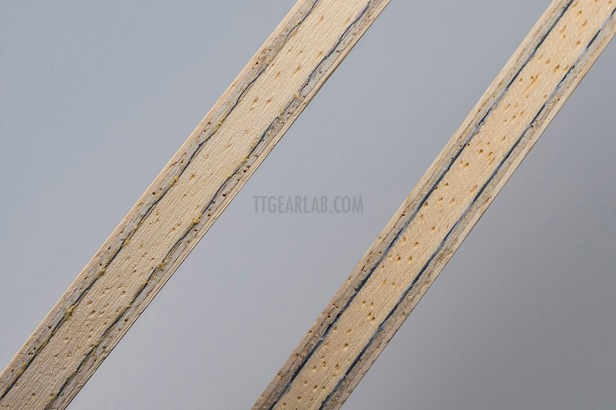
Fig.06 The constructions of ‘Shang Kun Hybrid ZC’ (left) and ‘Shang Kun Hybrid AC’ (right)
Both of ‘Shang Kun Hybrid ZC’ and ‘Shang Kun Hybrid AC’ are blades with ‘5+2 ply inner-fiber construction’. Fiber is inserted between middle layer and center layer. The appearance of the constructions of two blades look almost identical. The thickness of ‘Shang Kun Hybrid ZC’ (left) is about 5.8mm, And, the thickness of ‘Shang Kun Hybrid AC’ is also about 5.8mm. For both of two blades, top layer is Limba and center layer is Ayous. It is interesting that middle layer seems to be different from the middle layers of most of the blades with inner-fiber construction for example ‘InnerForce Layer ZLC’. The middle layer of ‘Shang Kun Hybrid ZC’ or ‘Shang Kun Hybrid AC’ look like Limba while the middle layer of Butterfly ‘InnerForce Layer ZLC’ or ‘InnerForce Layer ALC’ is Ayous. It is expected that this difference will make the difference in mechanical characteristics.
2. Blades to be compared
Because the two models of ‘Shang Kun’ series are inner-fiber blades, we will be able to compare ‘Shang Kun Hybrid ZC’ (avg. weight 92.0g) and ‘Shang Kun Hybrid AC’ (avg. weight 88.8g) with some existing inner-fiber blades. Five blades with ‘5+2 ply inner fiber construction’ will be compared with two models of ‘Shang Kun’ series :
- Butterfly ‘InnerForce Layer ZLC’ : inner ZLC (avg. weight 89.8g)
- Butterfly ‘InnerForce Layer ALC (2023)’ : inner ALC (avg. weight 91.2g) [thicker, heavier and faster than 2018 version.]
- Butterfly ‘InnerForce Layer ALC (2018)’ : inner ALC (avg. weight 88.1g) [thinner, lighter and slower than 2023 version.]
For further understanding, two blades with ‘5+2 ply outer fiber construction’ will be compared at the same time :
- Butterfly ‘Timo Boll ALC’ : the representative of outer-fiber blade
- Tibhar ‘Cedric Nuytinck’ : outer Hybrid ZC (= ZLC)
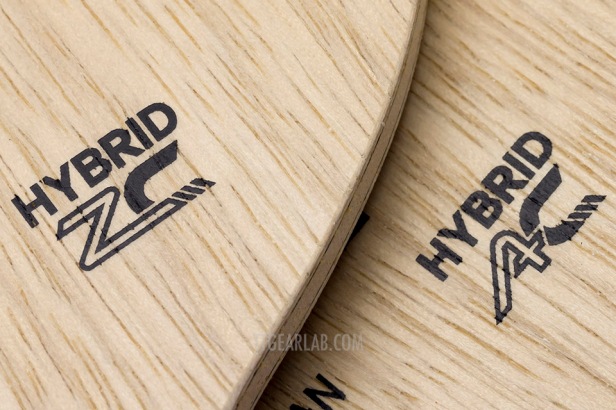
Fig.07 Tibhar ‘Shang Kun’ series
Comparison will be done by performance indices. Concerning the detail of four performance indices, please refer to following articles in ‘Background’ section :
- Performance indices : the way to evaluate blade by measurement
- The example of comparison by performance indices
3. Comparison by Performance Indices

Fig.08 Comparison by Elasticity Indices
Fig.08 shows the comparison graph of Elasticity Indices of two new blades and nine existing blades.
Ep (Primary Elasticity Index) is directly concerned with the rebound speed of blade. Ec (Central Elasticity Index) is concerned with additional ‘kick’ when player hits ball very hard. The Ep and the Ec of ‘Shang Kun Hybrid ZC’ are 2.19 and 1.86 respectively. And, the Ep and the Ec of ‘Shang Kun Hybrid AC’ are 1.87 and 1.60 respectively. ‘Shang Kun Hybrid ZC’ is noticeably faster than ‘Shang Kun Hybrid AC’. And, for both of two blades, Central Elasticity Indices (Ec’s) are noticeably lower than Primary Elasticity Indices (Ep’s).
The comparison shows that two new blades are faster than existing inner-fiber blades. With Ep = 2.19, ‘Shang Kun Hybrid ZC’ is the fastest one among all blades in the comparison. It is also noticeably faster than ‘InnerForce Layer ZLC’ (Ep = 1.90) which can be its direct competitor. ‘Shang Kun Hybrid AC’ whose Ep is 1.87 is as fast as ‘InnerForce Layer ZLC’ and ‘InnerForce Layer ALC (2023)’, and is noticeably faster than ‘InnerForce Layer ALC (2018)’. [2018 version of ‘InnerForce Layer ALC’ is thinner, lighter and slower than 2023 version.] All blades in the comparison shows the tendency that Ec is smaller than Ep.
‘Shang Kun Hybrid ZC’ is noticeably faster than ‘InnerForce Layer ZLC’, and ‘Shang Kun Hybrid AC’ is as fast as ‘InnerForce Layer ALC (2023)’. [2023 version of ‘InnerForce Layer ALC’ is thicker, heavier and faster than 2018 version.]
‘Shang Kun Hybrid ZC’ is even faster than ‘Cedric Nuytinck’ which is a ‘Hybrid ZC’ blade with outer-fiber construction. And, interestingly the Elasticity Indices of ‘Shang Kun Hybrid ZC’ is similar to those of ‘Timo Boll ALC’. Although there is the problem of the difference of top layer, the players who have used ‘Timo Boll ALC’ may be able to easily move to ‘Shang Kun Hybrid ZC’.
Examining Ec/Ep is an easier way to understand the characteristics of blade concerned with elasticity. Fig.09 shows the relationship between Ec/Ep and Ep.
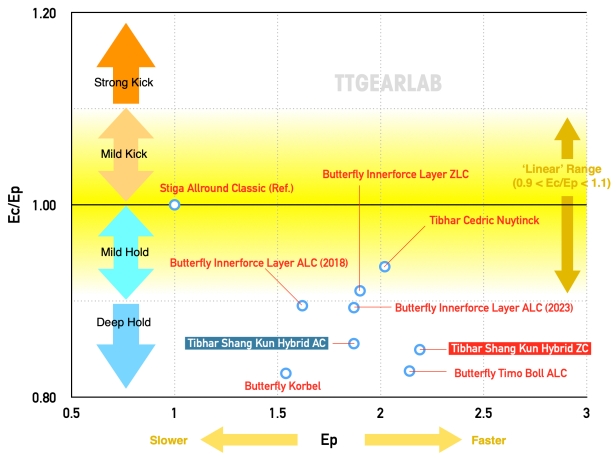
Fig.09 Ec/Ep vs. Ep
Ec/Ep expresses the ‘tendency’ of the elasticity of blade. By examining Ec/Ep and Ep at the same time, we can easily understand the behavior of blades.
On the graph, all blades except for reference blade are in ‘Hold’ range (Ec/Ep < 1.0). And, both of ‘Shang Kun Hybrid ZC’ and ‘Shang Kun Hybrid AC’ are placed in ‘Deep Hold’ rage (Ec/Ep < 0.9). It means that both of ‘Shang Kun Hybrid ZC’ and ‘Shang Kun Hybrid AC’ hold ball very deep when player hit the ball very strongly. That makes continuous topspin at close-to-table area very easy and stable.
‘InnerForce Layer ZLC’ are located in ‘Mild Hold’ range, and two versions of ‘InnerForce Layer ALC’ (slower 2018 version and faster 2023 version) are located close to the border between ‘Mild Hold’ range and ‘Deep Hold’ range. That expresses the difference between new ‘Shang Kun’ series and ‘InnerForce Layer’ series.
Also, ‘Shang Kun Hybrid ZC’ is very close to ‘Timo Boll ALC’ on the graph. We may be able to categorize ‘Shang Kun Hybrid ZC’ and ‘Timo Boll ALC’ into one group : fast blades that hold ball very deep when player makes very strong impact. That is for aggressive players who play with topspin at close-to-table area.
And, if a player wants the same ‘Deep Hold’ character of that group but thinks that the blades in that group are somewhat too fast, ‘Shang Kun Hybrid AC’ can be a good candidate. And, if a player wants a blade that is as fast as ‘InnerForce Layer ALC (2023)’ or ‘InnerForce Layer ZLC’ but requires more hold, ‘Shang Kun Hybrid AC’ may be an ideal choice.
Then successively, let’s compare Vibration Indices. Fig. 10 shows the comparison graph of Vibration Indices.

Fig.10 Comparison by Vibration Indices
Vibration Indices are concerned with feeling. Vp indicates primary feeling which is transferred to player’s palm. And, Vl is the feeling at the wing of a blade. It is felt by player’s index finger or middle finger.
The Vp and the Vl of ‘Shang Kun Hybrid ZC’ are 1.26 and 1.38. And, the Vp and the Vl of ‘Shang Kun Hybrid AC’ are 1.20 and 1.34. The values of ‘Shang Kun Hybrid ZC’ are a bit higher than the values of ‘Shang Kun Hybrid AC’. But, the difference is not significant.
The Vibration Indices of ‘Timo Boll ALC’ are very similar to those of ‘Shang Kun Hybrid ZC’. Especially the high level of the Vl’s of those two blades is noticeable. ‘InnerForce Layer ZLC’ shows similar Vp to ‘Shang Kun Hybrid ZC’. However, Vl of ‘InnerForce Layer ZLC’ is much lower than that of ‘Shang Kun Hybrid ZC’. Therefore, nobody will feel that ‘Shang Kun Hybrid ZC’ is similar to ‘InnerForce Layer ZLC’.
The Vp of ‘Shang Kun Hybrid AC’ (= 1.20) is same as that of ‘InnerForce Layer ALC (2023)’. However, the Vl of ‘InnerForce Layer ALC (2023)’ is significantly lower than that of ‘Shang Kun Hybrid AC’. Some players may feel that ‘Shang Kun Hybrid AC’ is similar to ‘InnerForce Layer ALC (2023)’. But, there will be also many players who don’t agree.
‘Cedric Nuythnck’ is also much different from ‘Shang Kun Hybrid ZC’ in Vibration Indices, and looks like harder version of ‘InnerForce Layer ZLC’.
Examining Vl/Vp is the easier way for the comparison of the tendency of feeling. Fig.11 shows the relationship between Vl/Vp and Vp for easier comparison.

Fig.11 Vl/Vp vs. Vp
On the graph of Vl/Vp, seven blades are in ‘relatively sharper at finger’ range (Vl/Vp > 1.0), and the other three blades are in ‘relatively more comfortable at finger’ range (Vl/Vp < 1.0). The three blades in ‘relatively more comfortable at finger’ range are close to ‘uniform’ line (Vl/Vp = 1.0).
Both of ‘Shang Kun Hybrid ZC’ and ‘Shang Kun Hybrid AC’ are in ‘relatively sharper at finger’ range (Vl/Vp > 1.0), and the values are close to 1.1. Both of ‘Shang Kun Hybrid ZC’ and ‘Shang Kun Hybrid AC’ give relatively sharp feeling at finger. But, the sharpness isn’t extreme. On the graph, ‘Timo Boll ALC’ is very close to ‘Shang Kun Hybrid ZC’ and Shang Kun Hybrid AC’
‘InnerForce Layer ZLC’ is very close to the neutral line (Vl/Vp = 1.0). Therefore, we can easily understand that ‘Shang Kun Hybrid ZC’ is completely different from ‘InnerForce Layer ZLC’ in feeling. It is interesting that the feeling of ‘Shang Kun Hybrid ZC’ is close to that of ‘Timo Boll ALC’ which has different fiber and different construction from ‘Shang Kun Hybrid ZC’. Also, ‘Cedric Nuytinck’ which is an outer-fiber blade is close to ‘InnerForce Layer ZLC’. Those examples in this comparison gives us a good lesson : “Don’t hastily expect the feeling of blade just from the type of construction (= inner or outer).”
‘Shang Kun Hybrid AC’ shows noticeably higher value of Vl/Vp than ‘InnerForce Layer ALC’ (both of 2018 version and 2023 version). ‘InnerForce Layer ALC (2023)’ is even on the neutral line (Vl/Vp = 1.0) while ‘Shang Kun Hybrid AC’ is located in the area over uniform range. That is significant difference, and players will feel that ‘Shang Kun Hybrid AC’ is totally different from ‘InnerForce Layer ALC (2023).’ Instead, ‘Shang Kun Hybrid AC’ is close to ‘Timo Boll ALC’ on the graph. If a player wants the blade that gives sharper feeling than ‘InnerForce Layer ALC’ but doesn’t want different fiber or outer-fiber construction, ‘Shang Kun Hybrid AC’ is seriously considerable.
4. Summary
Tibhar ‘Shang Kun’ series is a new blade family named under Chinese player – Shang Kun. It includes two blades with inner-fiber constructions. Two kinds of fiber are used for ‘Shang Kun’ series. ‘Shang Kun Hybrid ZC’ is equipped with ‘Hybrid ZC’ (= ZLC) which had already announced with ‘Kinetic Speed’ and ‘Cedric Nuytinck’. And, the fiber for ‘Shang Kun Hybrid AC’ is ‘Hybrid AC’ (= ALC) that is firstly shown with this series. The characteristics of ‘Shang Kun Hybrid ZC’ and ‘Shang Kun Hybrid AC’ can be summarized as follows :

- ‘Shang Kun Hybrid ZC’ is the faster one between two models of ‘Shang Kun’ series. It is noticeably faster than ‘InnerForce Layer ZLC’ which will be mostly compared with it by many players. ‘Shang Kun Hybrid ZC’ is even a bit faster than ‘Timo Boll ALC’ which is the representative of fiber blades with outer-fiber construction.
- ‘Shang Kun Hybrid ZC’ holds ball very deep when player hits ball very strongly. On the graph of Elasticity characteristics, ‘Shang Kun Hybrid ZC’ is very close to ‘Timo Boll ALC’. Also, ‘InnerForce Layer ALC (2023)’ is close to ‘Shang Kun Hybrid ZC’.
- The feeling of ‘Shang Kun Hybrid ZC’ is also close to that of ‘Timo Boll ALC’ even though everything – top layer, fiber and type of construction – of ‘Shang Kun Hybrid ZC’ is different from that of ‘Timo Boll ALC’. (But, it is expected that the feeling of ‘Shang Kun Hybrid ZC’ will be more natural than that of ‘Timo Boll ALC’, thanks to inner-fiber construction. The value that indicates how natural the feeling is isn’t included in four Performance Indices.)
- ‘Shang Kun Hybrid ZC’ gives a bit hard primary feeling, and is relatively sharper at finger. It is apparently different from the feeling of ‘InnerForce Layer ZLC’ which gives a bit more comfortable at finger.
- It is expected that ‘Shang Kun Hybrid ZC’ can be good recommendation for the players who like the speed and the hold characteristics of ‘Timo Boll ALC’ but is looking for more natural feeling. Also it will be good recommendation for the players who want to the replacement of ‘Korbel’ for the enhancement of power.

- ‘Shang Kun Hybrid AC’ is relatively slower one between two models of ‘Shang Kun’ series. However, it is faster than ‘InnerForce Layer ALC (2018)’, and is as fast as ‘InnerForce Layer ALC (2023)’ or ‘InnerForce Layer ZLC’.
- ‘Shang Kun Hybrid AC’ holds ball very deep when player hits ball very strongly. It holds ball deeper than ‘InnerForce Layer ALC (2018 and 2023)’ and ‘InnerForce Layer ZLC’.
- The feeling of ‘Shang Kun Hybrid AC’ is not much different from that of ‘Shang Kun Hybrid ZC’ although it is a bit softer and provides a bit sharper relative feeling at finger.
- ‘Shang Kun Hybrid AC’ gives sharper relative feeling than ‘InnerForce Layer ALC (2018 or 2023)’. Player will feel noticeable difference between ‘Shang Kun Hybrid AC’ and ‘InnerForce Layer ALC (2018 or 2023)’. ‘Shang Kun Hybrid AC’ is closer to ‘Timo Boll ALC’ although it is a somewhat softer.
- ‘Shang Kun Hybrid ZC’ can be recommended for players who want the blade which is faster and harder than ‘InnerForce Layer ALC’ but provides deeper hold. ‘Deeper hold’ is the advantage of ‘Shang Kun Hybrid AC’ when it is compared with many existing inner-fiber blades. But, for the players who doesn’t like deep hold, it will be the disadvantage of ‘Shang Kun Hybrid AC’. ‘Shang Kun Hybrid AC’ can also be recommended for players who are searching for the faster replacement of ‘Korbel’ but doesn’t want the blade as fast as ‘Timo Boll ALC’.
‘Shang Kun Hybrid ZC’ is faster than most of existing inner-fiber blades with similar thicknesses. ‘Enhanced rebound’ will be the best expression that explains ‘Shang Kun Hybrid ZC’. Especially the players who have been eager for power will be satisfied by ‘Shang Kun Hybrid ZC’. And, ‘Shang Kun Hybrid AC’ can be considered as the variation of ‘Shang Kun Hybrid ZC’ that provides a bit reduced speed. Players will be able to select between two models of ‘Shang Kun’ series just by speed because ‘Shang Kun Hybrid ZC’ and ‘Shang Kun Hybrid AC’ are very similar to each other in all features except for speed.


Thank you so much, I needed this before purchasing 🙂
LikeLike
Thank you for comment! 😉
LikeLike
How thick are the fl handles? compared to say a tbalc fl or viscaria fl? Great review btw
LikeLike
Thank you for comment.
The FL of ‘Shang Kun Hybrid AC’ is not ‘thicker’ but ‘wider’ than that of TB ALC. At the middle of handle, it is thinner by 0.9mm and wider by 1.0mm than the FL of TB ALC.
But, that is only the story of the middle part of handle.
At the end of handle, it is ‘thicker(!!!)’ by 0.8mm and wider by 1.0mm than the FL of TB ALC.
In actual use, I felt that ‘Shang Kun Hybrid AC’ gives much firmer grip than ‘TB ALC’. You will notice that it will not play in your hand.
The FL of Viscaria is a bit wider and a bit thinner than the FL of TB ALC. Of course you will feel that the FL of ‘Shang Kun Hybrid AC’ is thicker.
(I can’t tell it by values because recent version of Viscaria isn’t currently in my hand.)
LikeLike
First off, awesome website!
Glad to see an inner alc w/ a 102mm or longer handle. It seems everything is 100mm now. In the future can you make sure to include handle length, always? Large hand readers will be very happy : )
thanks 🙏
LikeLike
Great review as always. Can you please elaborate what you mean by ” Hold “? Is it same as ” Dwell ” characteristic? My understanding is the more ” Dwell ” the more spin, am I correct?
LikeLike
Strictly speaking, ‘dwell’ is not concerned with Hold or Kick.
Many players think that the ball dwells longer on some blades. But, that is not truth. That is no more than the result of feeling.
The dwelling time is concerned of the kind of ball. That is due to the unique structure of table tennis ball. (Hard and thin shell. Totally empty inside.) Table tennis ball behaves differently from the ball for other sports. And, if the ball is same, the dwelling time on the surface of rubber is always same without concerning the characteristics of blade.
LikeLike
please do testing for joola rossi emotion and joola rossi emotion pbo-c
LikeLike
Kudo’s for latest revision!
What was/is the weight of the AC you tested?
LikeLike
The average weight is 88.8g. (I will add the weight information to all articles.)
LikeLike
Awesome! Greatly appreciated!
LikeLike
Just added. I will also update the other articles.
LikeLike
Great review! I would like to buy the AC version but i didnt find any info about ST handle dimensions, can you tell me please? Or atleast compare with other blades. Thx
LikeLike
Thank you a lot! Shang Kun Hybrid AC has a ST handle that gives firm grip. Currently I don’t have it in my hand, and I forgot to memorize the exact data of handle size of it. However, I remember that its width is 28mm, and its height (thickness) is over 23mm.
LikeLike
Lovely blog you haave
LikeLike
Thank you a lot!
LikeLike
Congrats for the great review!!!
Helped me to buy the AC and i can say is the best feel i ever had with a blade (and i tryed alot of them, from Primorac Carbon, Zhang Jike Alc, Tibhar Samsonov Force Pro Black Edition, Donic Waldner WC 89, Timo Boll Zlc and Viscaria).
My Top would by Shang Kun AC, Tibhar Samsonov Force Pro Black Edition and Viscaria.
LikeLike
love your work.
i did see recently you review xiom tmxi blade, compared with shang kun zc how is the fl handle?
i really like viscaria fl handle and i want similar, unfortunatelly tmx is not avalaible in europe.
LikeLike
Thank you a lot for comment.
Currently I don’t have SK Hybrid ZC FL in my hand. But, I remember that it is quite similar to Viscaria FL.
But, another problem of SK series is that its head is quite big. In my opinion, it is too big for most of players, although probably professional players will like that size.
By the way, if you can buy Tibhar blades, you will be able to consider MK Carbon (outer) or Libra ZAC (inner). Both of those have FL handles similar to Viscaria FL.
LikeLike